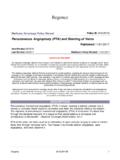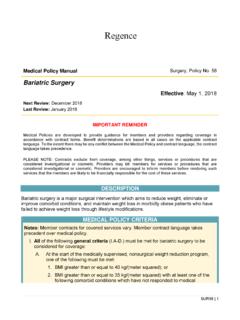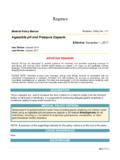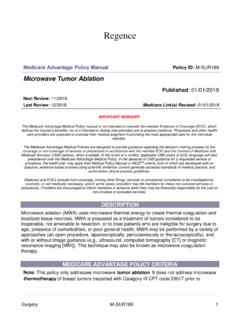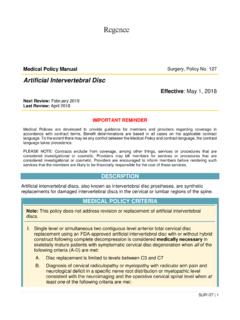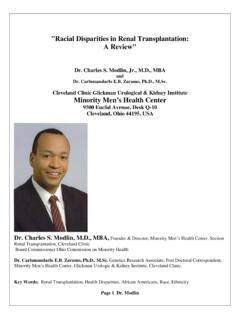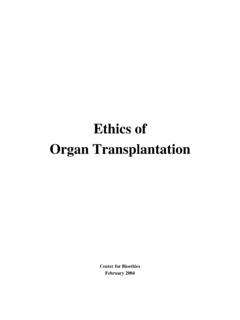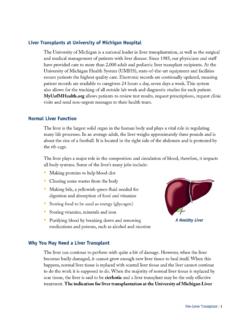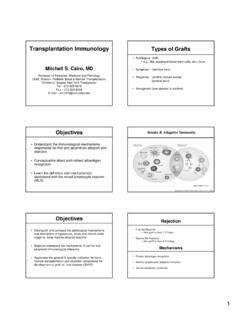Transcription of Hematopoietic Cell Transplantation in the Treatment of ...
1 | 1 Medical Policy Manual Transplant, Policy No. Hematopoietic Cell Transplantation in the Treatment of Germ-Cell Tumors Effective: November 1, 2019 Next Review: August 2020 Last Review: S eptember 2020 IMPORTANT REMINDER Medical Policies are developed to provide guidance for members and providers regarding coverage in accordance with contract terms. Benefit determinations are based in all cases on the applicable contract language. To the extent there may be any conflict between the Medical Policy and contract language, the contract language takes precedence. PLEASE NOTE: Contracts exclude from coverage, among other things, services or procedures that are considered investigational or cosmetic.
2 Providers may bill members for services or procedures that are considered investigational or cosmetic. Providers are encouraged to inform members before rendering such services that the members are likely to be financially responsible for the cost of these services. DESCRIPTION Hematopoietic cell Transplantation is performed to restore normal function following chemotherapy Treatment . MEDICAL POLICY CRITERIA I. Single autologous h ematopoietic cell Transplantation may be considered medically necessary in the Treatment of germ-cell tumors for either of the following (A. or B.): A. For patients with favorable prognostic factors that have failed a previous course of conventional-dose salvage chemotherapy.
3 Patients with favorable prognostic factors include those with a testis or retroperitoneal primary site, a complete response to initial chemotherapy, low levels of serum markers, and low volume disease. B. For patients with unfavorable prognostic factors as initial Treatment of first relapse ( , without a course of conventional-dose salvage chemotherapy) and in patients with platinum-refractory disease. Patients with unfavorable prognostic factors are those with an incomplete response to initial therapy or relapsing mediastinal nonseminomatous germ-cell tumors. | 2 II. Tandem autologous hemopoietic cell Transplantation or transplant with sequential high-dose chemotherapy may be considered medically necessary in the Treatment of testicular tumors, either as salvage therapy or for those with platinum-refractory disease.
4 III. Hematopoietic cell Transplantation is considered investigational in the Treatment of germ-cell tumors for any of the following: A. Autologous hemopoietic cell Transplantation as a component of first-line Treatment for germ-cell tumors. B. Tandem autologous hemopoietic cell Transplantation or transplant with sequential high-dose chemotherapy for all other germ-cell tumors of any stage not addressed in Criterion II. C. Allogenic hemopoietic cell Transplantation for any germ-cell tumors, including, but not limited to its use as therapy after failed autologous Hematopoietic cell Transplantation . NOTE: A summary of the supporting rationale for the policy criteria is at the end of the policy.
5 POLICY GUIDELINES DEFINITIONS Consolidation therapy: Treatment that is given after cancer has disappeared following the initial therapy. Consolidation therapy is used to kill any cancer cells that may be left in the body. It may include radiation therapy, a stem cell transplant, or Treatment with drugs that kill cancer cells . Also called intensification therapy and postremission therapy. Relapse: The return of a disease or the signs and symptoms of a disease after a period of improvement. Salvage therapy: Treatment that is given after the cancer has not responded to other treatments. Tandem transplant: Refers to a planned second course of high-dose therapy and HCT within six months of the first course.
6 LIST OF INFORMATION NEEDED FOR REVIEW It is critical that the list of information below is submitted for review to determine if the policy criteria are met. If any of these items are not submitted, it could impact our review and decision outcome. History and physical/chart notes Diagnosis and indication for transplant CROSS REFERENCES 1. Donor Lymphocyte Infusion for Malignancies Treated with an Allogeneic Hematopoietic Cell Transplant, Transplant, Policy No. 2. Placental and Umbilical Cord Blood as a Source of Stem cells , Transplant, Policy No. 3. Hematopoietic Cell Transplantation for Epithelial Ovarian Cancer, Transplant, Policy No. 4. Hematopoietic Cell Transplantation for Miscellaneous Solid Tumors in Adults, Transplant, Policy No.
7 | 3 5. Hematopoietic Cell Transplantation for Solid Tumors of Childhood, Transplant, Policy No. BACKGROUND Hematopoietic CELL Transplantation Broadly speaking, there are two types of Hematopoietic cell transplants (HCT, previously referred to in this policy as a Hematopoietic stem cell transplant [HSCT]), autologous and allogeneic. The purpose of an autologous HCT is to treat a disease ( lymphoma) with myeloablative doses of chemotherapy (with or without radiation) that are active against the disease. The recipient s own HCTs (collected previously) are infused after the chemotherapy in order to re-establish normal marrow function. In an allogeneic transplant, the recipient receives HCTs from a donor after myeloablative therapy or non-myeloablative therapy in order to re-establish normal marrow function as well as to use the new blood system as a platform for immunotherapy, a so called graft versus tumor effect.
8 Hematopoietic cells can be harvested from bone marrow, peripheral blood, or umbilical cord blood shortly after delivery of neonates. Although cord blood is an allogeneic source, the cells in it are antigenically na ve and thus are associated with a lower incidence of rejection or graft-versus-host disease (GVHD). Immunologic compatibility between infused Hematopoietic stem cells and the recipient is not an issue in autologous HCT. However, immunologic compatibility between donor and patient is a critical factor for achieving a good outcome of allogeneic HCT. Compatibility is established by typing of human leukocyte antigens (HLA) using cellular, serologic, or molecular techniques. HLA refers to the tissue type expressed at the Class I and Class II loci on chromosome 6.
9 Depending on the disease being treated, an acceptable donor will match the patient at all or most of the HLA loci (with the exception of umbilical cord blood). CONVENTIONAL PREPARATIVE CONDITIONING FOR HCT The conventional ( classical ) practice of allogeneic HCT involves administration of cytotoxic agents ( , cyclophosphamide, busulfan) with or without total body radiation at doses sufficient to destroy endogenous Hematopoietic capability in the recipient. The beneficial Treatment effect in this procedure is due to a combination of initial eradication of malignant cells and subsequent graft-versus-malignancy (GVM) effect mediated by non-self immunologic effector cells that develop after engraftment of allogeneic stem cells within the patient s bone marrow space.
10 While the slower GVM effect is considered to be the potentially curative component, it may be overwhelmed by extant disease without the use of pretransplant conditioning. However, intense conditioning regimens are limited to patients who are sufficiently fit medically to tolerate substantial adverse effects that include pre-engraftment opportunistic infections secondary to loss of endogenous bone marrow function and organ damage and failure caused by the cytotoxic drugs. Furthermore, in any allogeneic HCT, immune suppressant drugs are required to minimize graft rejection and GVHD, which also increases susceptibility of the patient to opportunistic infections. The success of autologous HCT is predicated on the ability of cytotoxic chemotherapy with or without radiation to eradicate cancerous cells from the blood and bone marrow.
